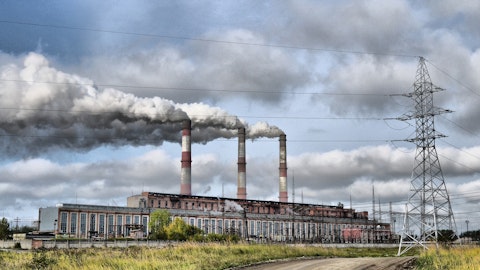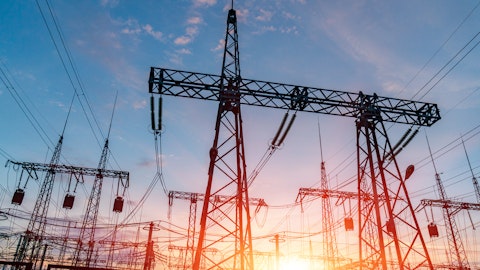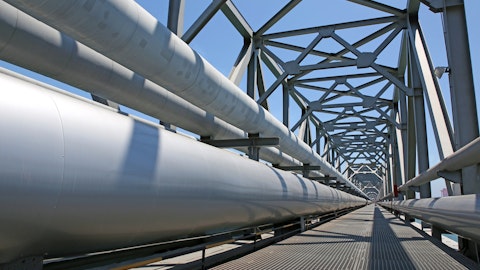The AES Corporation (NYSE:AES) Q1 2023 Earnings Call Transcript May 5, 2023
The AES Corporation misses on earnings expectations. Reported EPS is $0.22 EPS, expectations were $0.23.
Operator: Good morning. Thank you for attending today’s The AES Corporation First Quarter 2023 Financial Review. My name is Alicia, and I’ll be your moderator for today’s call. I would now like to pass the conference over to your host, Susan Harcourt, Vice President of Investor Relations with AES Corporation. You may now proceed.
Susan Harcourt: Thank you, operator. Good morning, and welcome to our first quarter 2023 financial review call. Our press release, presentation and related financial information are available on our website at aes.com. Today, we will be making forward-looking statements. There are many factors that may cause future results to differ materially from these statements, which are discussed in our most recent 10-K and 10-Q filed with the SEC. Reconciliations between GAAP and non-GAAP financial measures can be found on our website along with the presentation. Joining me this morning are Andres Gluski, our President and Chief Executive Officer; Steve Coughlin, our Chief Financial Officer; and other senior members of our management team. With that, I will turn the call over to Andres.
Andres Gluski: Good morning, everyone. And thank you for joining our first quarter 2023 financial review call. We are very pleased with our progress so far this year. And today, I will discuss our first quarter results and provide key business updates. Steve Coughlin, our CFO, will give some more detail on our financial performance and outlook. Beginning on Slide 3. As you may have seen in our press release, we introduced new strategic business units, which better reflect the greatly simplified company that AES is today and the pillars of our future growth. We will be giving a broader strategic review at our Investor Day on Monday, including an update on our portfolio transformation and an overview of our strong growth expectations for our renewables and utility businesses.
Our first quarter 2023 adjusted earnings per share was $0.22 compared with $0.21 in 2022, which is in line with our expectations. With these results and the underlying performance we are seeing across our business, we are reaffirming our 2023 adjusted earnings per share guidance of $1.65 to $1.75, and our 7% to 9% annualized growth rate target through 2025. Now turning to Slide 4. We continue to see strong demand for renewables both in the U.S. and internationally, including from U.S. corporate customers with operations in international markets. So far this year, we have signed PPAs for 309 megawatts of new renewables, including 154 megawatts of wind with a U.S. technology customer in Brazil. We’re in advanced negotiations for several large additional projects and remain on track to meet our PPA signing target of 14 to 17 gigawatts over the next 3 years.
In the U.S., key elements of the inflation Reduction Act or IRA are being clarified. This past month, the Department of Treasury and the IRS release detailed guidance on how clean energy projects located in energy communities can qualify for an additional 10% bonus tax credit. We estimate that approximately 1/3 of our 51 gigawatt pipeline of projects in the U.S. would qualify, which directly translates into a combination of higher potential returns and increased competitiveness for the projects we are developing. We are currently awaiting treasury department guidance on certain provisions of the IRA, including requirements for the clean hydrogen production tax credit. As a reminder, at our green hydrogen project in Texas, the largest advanced green hydrogen project in the U.S., which we are developing jointly with Air Products.
We plan to co-locate 1.4 gigawatts of new renewables with the electrolyzers. This means that the projects would have the lowest possible carbon emissions of any known project in the U.S. Additionally, the project is located adjacent to the site of a decommissioned coal plant, which will provide significant existing infrastructure. All of these attributes and the fact that the energy will include hourly matching indicate that the project should qualify for the highest possible tax credit in any scenario. Turning to Slide 5. Our backlog of projects with signed long-term contracts is now around 12 gigawatts. Of which roughly half are already under construction. We continue to maintain a robust supply chain, and we continue to hit our construction milestones without delay.

Photo by Ronan Furuta on Unsplash
We expect to bring online more than 3 gigawatts of new wind, solar and battery storage this year. As we bring projects currently in the backlog online in coming years, we will nearly double our installed renewables capacity, making us one of the fastest-growing renewable companies in the world. Turning to Slide 6. We are also happy to report a positive development at AES Ohio which puts us on track for unprecedented growth in the business. In April, AES Ohio signed a comprehensive settlement agreement for its Electric Security Plan, or ESP 4 which received broad support from residential, commercial, industrial and low-income customers. The settlement included the commission staff as a signatory, and we expect to receive final approval by the end of the third quarter.
With ESP 4 in place, along with our existing investment programs, we expect to more than double our rate base by the end of 2027 which would make AES Ohio, one of the fastest-growing utility businesses in the country, while still having the lowest tariffs in the state. Turning to Slide 7. We also reached a major milestone towards exiting coal by the end of 2025. We agreed to terminate the PPA at the Warrior Run plant in Maryland, for which we will receive total payments of $357 million. We will retain control of the site and are exploring new uses that capitalize on its valuable location and existing infrastructure. We see this transaction is very beneficial for all parties involved. Moving to Slide 8. We signed agreements to extend the operations of 1.4 gigawatts of gas generation at our legacy Southland units in California for 3 more years.
These plans were previously scheduled to retire at the end of this year. The extensions will lock in additional upside and will help meet the state of California’s grid liability needs while supporting its efforts to transition over time to low carbon source of electricity. The monetization of the contract that Warrior Run and the extension of the legacy Southland units are both good examples of how we are creating value from our existing infrastructure assets during the energy transition. Finally, as I mentioned earlier, we will be holding an Investor Day on Monday, where we will be sharing our strategic long-term view of the company, discussing our new business segments and providing long-term growth rates through 2027 for adjusted earnings per share, adjusted EBITDA and parent free cash flow.
With that, I would like to turn the call over to our CFO, Steve Coughlin.
Steve Coughlin: Thank you, Andres, and good morning, everyone. Today, I will discuss our first quarter results, 2023 guidance and 2023 parent capital allocation. Turning to Slide 10. As Andres mentioned, in the first quarter, we launched our new Strategic Business Units or SBUs. This new organizational structure reflects AES very focused and simplified portfolio. It also aligns our management teams by business line to maximize our operational synergies and to continue delivering excellent customer experiences across all our markets. Our new SBU reporting segments highlight our rapidly growing renewables and utility businesses and facilitate simplified modeling of AES, which will benefit current and new potential shareholders and analysts.
Our new SBUs include renewables, which includes our solar, wind, energy storage and hydro businesses, utilities, which includes AES Indiana, AES Ohio and AES Salvador, Energy infrastructure composed of our thermal generation and LNG infrastructure businesses and new energy technologies, which includes our investments in energy technology businesses such as Fluence and Uplight as well as our green hydrogen business line and future new business innovations which support our mission. In addition to the SBUs, we also have a corporate reporting segment, which includes our corporate G&A our parent level debt and associated interest expense in our captive insurance program called AGC. Turning to Slide 11. Adjusted EPS for the quarter was $0.22 versus $0.21 last year.
Our business was favorable year-over-year, which I will discuss in more detail shortly. Our results were also impacted by higher parent interest expense and a lower adjusted tax rate. Now to Slide 12. We are fully on track to achieve our full year 2023 adjusted EPS guidance range of $1.65 to $1.75. We expect a significant contribution from new renewables of at least $0.27 this year. This is partially offset by lower contributions from LNG sales, as we have previously mentioned, higher parent interest expense from incremental debt and higher rates on our revolving credit facility and a marginally higher tax rate this year. As is typically the case, our earnings are heavily weighted toward the second half of the year. This year, we expect approximately 3/4 of our earnings to occur in the second half.
Growth in the year to go will be primarily driven by contributions from new businesses including over 3 gigawatts of projects in our backlog coming online, which remains solidly on track for completion. We are also reaffirming our expected 7% to 9% average annual growth target through 2025. Turning to Slide 13. As you may have seen in our press release, while we continue to report adjusted EPS, today, we are also introducing adjusted EBITDA as a new reporting metric. As the renewables portion of our business grows at an extremely high rate, we believe adjusted EBITDA is a very informative metric in understanding our business results. First, it aligns well with the performance of our underlying business and operating cash generation. And second, adjusted EBITDA is reported before the impact of U.S. renewables tax attributes so that investors and analysts can separate renewable operating earnings from the very valuable tax incentives for U.S. renewables.
Beginning this quarter, I will discuss our new SBU financial results using adjusted EBITDA, with the exception of our utilities SBU, which will be measured using adjusted pretax contribution, or PTC, to facilitate comparisons with other utilities. We will provide full year guidance by SBU during our Investor Day on Monday. Adjusted EBITDA was $628 million this quarter versus $621 million in the prior year. This was driven by higher first quarter LNG sales and growth in renewables, but was partially offset by the impact of warmer than normal weather at our U.S. utilities. I’ll cover the performance of our new SBUs in the next 4 slides. Beginning with our renewables SBU on Slide 14. Higher EBITDA was driven primarily by a higher level of generation at our facilities in Panama higher wind generation and contributions from new businesses.
This was partially offset by higher spend as we continue to ramp up our renewables development and lower power prices impacting our Bulgaria wind facility. Lower PTC at our Utilities SBU was mostly driven by warmer-than-normal winter weather and higher interest expense, but partially offset by higher revenues as a result of our continued investment in the rate base. Higher EBITDA and our energy infrastructure SBU primarily reflects higher LNG sales, partially offset by lower margins from coal PPAs, the retirement of our coal plant in Hawaii last year and lower availability at Southland Energy. Finally, higher EBITDA at our New Energy Technologies SBU reflects a significant improvement in operations and gross margins at Fluence. Now to our 2023 parent capital allocation plan on Slide 18.
Sources reflect approximately $2.1 billion to $2.6 billion of total discretionary cash, including $950 million to $1 billion of parent free cash flow, $400 million to $600 million of proceeds from asset sales and $700 million to $1 billion of planned parent debt issuance. On the right-hand side, you can see our planned use of capital. We will return nearly $500 million to shareholders this year. This consists of our common share dividend, including the previously announced 5% increase as well as the coupon on the equity units. We plan to invest approximately $1.7 billion toward new growth, of which the majority will go to renewables and utilities. In summary, we’ve made great progress on our financial commitments for the year. At our Investor Day on Monday, we will provide detail on the strategy and future of AES overall and for each of our new SBUs. We will also provide long-term growth rates through 2027 for adjusted EPS, adjusted EBITDA and parent free cash flow.
I look forward to talking with many of you then. With that, I’ll turn the call back over to Andres.
Andres Gluski: Thank you, Steve. In summary, we are pleased with our progress to date and remain on track to hit our 2023 adjusted earnings per share guidance of $1.65 to $1.75 and our 7% to 9% annualized growth rate target through 2025. We continue to see strong demand for renewables and especially from our corporate customers. Our supply chain is robust and our construction projects are progressing as planned. We’re also encouraged by the settlement agreement at AS Ohio, which paves the way for final approval of our new electric security plan later this year and creates the framework for significant investments in the utility. Finally, we see our successful negotiations to terminate the Warrior Run contract and extend the operations of the 1.4 gigawatts of our legacy South line units as indicative of the success we are having in maximizing shareholder value from our existing assets as we transform the portfolio.
We look forward to providing a broader strategic update at our Investor Day on Monday, including more details around our growth plans and guidance through 2027. With that, I would like to open up the call for questions.
See also 20 Biggest Holding Companies in USA and 20 Most Desirable Companies To Work For In USA.
Q&A Session
Follow Aes Corp (NYSE:AES)
Follow Aes Corp (NYSE:AES)
Operator: Thank you The first question comes from the line of David Arcaro with Morgan Stanley. You may now proceed.
David Arcaro: Hi, good morning thanks for taking my question. One thing I wanted to check on, would there be any risk to your renewables growth outlook if the AD/CVD tariffs were to come back into effect just after we’ve seen the House and Senate passed some legislation there. Just curious how you view that risk and also just longer term, how you mitigate that AD/CVD tariff risk.
Andres Gluski: Yes, honestly, we don’t see any risk whatsoever. First, it in the past, I believe the setting was 56 votes, and that was — the President will be to it. And by the — we have all the panels that we need for this year, and expect to have for next year, by June of next year when the tariff, let’s say, tariff holiday rolls off. So we’re in very good shape for 2023 and 2024. And after that, we expect to have supply coming in from the U.S. We’re having no problems from our suppliers getting through under the UFLPA. So really, I think we’re in the best shape of anybody. We have not delayed a single project due to solar panel supply issues to date. And I think that’s something — I don’t know if anybody else can say that.
David Arcaro: Excellent. That’s helpful. And then I was just curious, any updates into the visibility for the 600 megawatts of projects that are potentially getting completed this year, but could get pushed to next year? Any increased visibility there at this point in the year?
Andres Gluski: Look, as I said in my script, we are progressing well we have the supply chain. Everything is in place. But look, we won’t know until the fourth quarter of this year, and they’re going to fall in this year and they’re going to follow in next. But I would remind everybody that’s not value issue. If they come in a couple of weeks later, it doesn’t affect the profitability of the project at all. It is an accounting issue. But as of now, we we’re doing well, but we can’t say — give you any particular update with greater clarity and probably until the fourth quarter of this year.
David Arcaro: Yes. Understood. That makes sense. And just one other quick question. I was curious if with the Warrior run project. Is there any level of EBITDA or earnings contribution that you would point to for that as that rolls off? And then curious how you think about the use of proceeds there if there’s debt specifically on the project that would be paid down or if it gets used more broadly at the corporate level?
Steve Coughlin: Yes, hi, this is Steve. There is definitely earnings from this. And so effectively, we’re monetizing the remaining 7 roughly years of the PPA this year. And so we’ll recognize earnings this year, and we expect to have an obligation for capacity through the middle of next year. So the earnings over this termination agreement will be recognized over roughly 11, 12 months following when the commission approval comes in. So say if it comes in, in June, probably about half this year and half next year. And there’s very little debt to pay down here. So this is — these proceeds will likely — this is a 7-year payment stream, but we’ll likely monetize that this year. And then that’s captured in our asset sale in terms of our capital sources this year, if you saw on that slide. So that will be used to fund the growth of the business.




